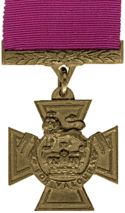James Munro (soldier)
James Munro | |
|---|---|
 | |
| Born | 11 October 1826 Nigg, Ross and Cromarty |
| Died | 5 February 1871 (aged 44) Inverness, Scotland |
| Buried | Craig Dunain Hospital Cemetery, Inverness |
| Service/ | British Army |
| Rank | Colour Sergeant |
| Unit | 93rd Regiment of Foot |
| Battles/wars | |
| Awards | Victoria Cross |
James Munro VC (11 October 1826 – 5 February 1871) was a Scottish recipient of the Victoria Cross, the highest and most prestigious award for gallantry in the face of the enemy that can be awarded to British and Commonwealth forces.
He was 20 when he joined up, and by 1854 he was a sergeant serving in the Crimean War. Eighteen months later, his regiment went to India and in 1857 Munro was promoted to colour sergeant.
James Munro received his medal from Queen Victoria at Windsor Castle in 1860, two years after he was discharged due to illness caused by his wounds.
Details[edit]
Munro was about 30 years old, and a colour-sergeant in the 93rd Regiment of Foot (Sutherland Highlanders), British Army during the Indian Mutiny when the following deed took place on 16 November 1857 at the Lucknow, India for which he was awarded the VC:
For devoted gallantry, at Secunderabagh, on the 16th November, 1857, in having promptly rushed to the rescue of Captain E. Walsh, of the same corps, when wounded, and in danger of his life, whom he carried to a place of comparative safety, to which place the Serjeant was brought in, very shortly afterwards, badly wounded.[1]
The medal[edit]
His Victoria Cross is displayed at the Argyll and Sutherland Highlanders Museum, Stirling Castle, Scotland.
See also[edit]
References[edit]
- ^ "No. 22445". The London Gazette. 8 November 1860. p. 4126.
- Monuments to Courage (David Harvey, 1999)
- The Register of the Victoria Cross (This England, 1997)
- Scotland's Forgotten Valour (Graham Ross, 1995)
External links[edit]
- British recipients of the Victoria Cross
- Argyll and Sutherland Highlanders soldiers
- 1826 births
- 1871 deaths
- British Army personnel of the Crimean War
- Indian Rebellion of 1857 recipients of the Victoria Cross
- People from Ross and Cromarty
- British Army recipients of the Victoria Cross
- Military personnel from Ross and Cromarty
